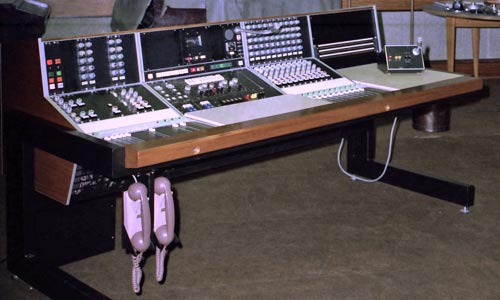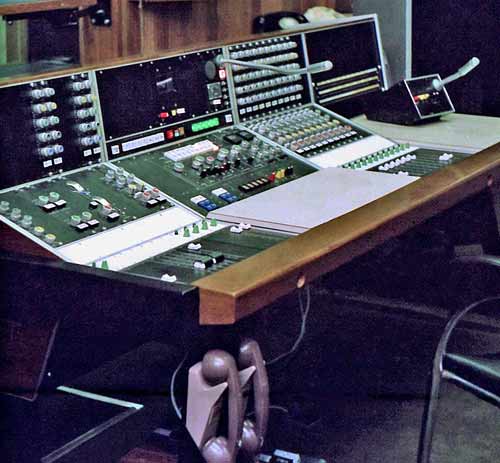
Fortunately, a number of UK sound mixing console manufacturers were gaining reputations in the recording industry and on investigation it was confirmed that many of their standard modules and components met the BBC's technical standards and could be used in broadcasting. The challenge for the BBC was to use as many of these as possible to keep the cost and production time to a minimum. There was an additional challenge to ensure the chosen manufacturers - Audix, Calrec & Neve were ergonomically sufficiently similar, so that BBC operational staff could move seamlessly between studios. The three manufacturers were willing to co-operate, enabling the GP refurbishment programme to get under way.
Meetings were held with - Radio Projects, the customer, and London Radio Programme Operations - the main source of the operational expertise and input. A hardboard mock-up was set up in BH London Studio 3A and a book was provided for people to record their comments and suggestions. Viewing was open to Radio Projects, Programme Operations and selected Designs Department and SP&ID engineers. In addition, programme departments were asked for their input and comments.
Some of the input and comments were very constructive but there were a number of conflicting requirements. The mock-up was important as ergonomics was a high priority with reach, script space, module facilities, layout and fader direction top of the list. Programme Operations wanted to experiment with a central script space and the project manager wanted acceptance for a change in the direction of the fader operation to that common to all

It was important that a prototype was built because the BBC senior management needed to know that a commercial company could supply a control desk that would meet the demanding BBC specifications, within an agreed timetable and for a competitive price. Funds were limited and it was essential that the prototype system was installed in an operational area to prove that the whole GP concept was viable and able to earn its keep. The Calrec prototype was initially installed in PP5 for Schools Broadcasting and later transferred to The Langham for Radio Training.
Within the constraints of practicality, time and budget, SP&ID's function was to provide what the users needed to produce the programmes but due to the poor communication of requirements to the designers, the desk was not well received and led to the formation of the Technical Consultative Committee to define future GP desks - the TCC was chaired by the SP&ID Project Manager. Realising any necessary design changes was the main reason for building a prototype and that it achieved. Once the TCC had done its work, the first production run of desks was ordered from Neve. These were Mark 1's for PP2 and PP4 and Mark 2's for PP1 and PP3. The prototype was replaced later with a Mk2 Audix.

The control desk was the most important part of the GP system, which included an apparatus bay, studio pattresses, an announcer's talkback unit, a tape control panel and power supply cabinet. It was not until the prototype proved that it was possible to build a commercial desk to the BBC's specifications and standards, that SP&ID and the TCC set about designing a whole range of GP Desks to satisfy specific programme requirements. After the success of the prototype desk, the GP replacement programme got underway and became the second most successful in the BBC after Type A.
By April 1983, sixty-five general purpose control desk systems had been ordered and were installed throughout the country as follows:- Broadcasting House (24), 1/1A Portland Place (5), Egton House (2), The Langham (2), Bush House (4), Maida Vale (1), Open University (1), Bristol (2), Glasgow (4), Edinburgh (4), Belfast (4), Manchester (1), Bangor (2), Cardiff (6), Swansea (1), Evesham (2).
In addition, considering the competitive nature of the supply, the three manufacturers shared the allocation fairly evenly as the table shows:-
| BBC equipment code: DK4/ | 26 | 27 | 28 | 33 | 35 | 36 | 34 | 37 | 38 | 40 |
| MK | 1 | 1A* | 2 | 2D | 3 | 3A | 4 | 4A | 4D | 4+ |
| Neve (24 desks) | 8 | 0 | 3 | 0 | 0 | 0 | 13 | 0 | 0 | 0 |
| Calrec (16 desks) | 0 | 7 | 4 | 1 | 2 | 2 | 0 | 0 | 0 | 0 |
| Audix (25 desks) | 3 | 0 | 5 | 5 | 0 | 0 | 1 | 3 | 3 | 5 |
| Total (65 desks) | 11 | 7 | 12 | 6 | 2 | 2 | 14 | 3 | 3 | 5 |
*includes two desks at Bush House which varied in several
respects including 2 extra groups, changes to the monitor panel, additional
ringmain feeds and cue light selection and a pre-transmission test panel.
Three teams of SP&ID engineers carried out the installations and because of the GP concept of "build and test off site, bring in and plug together" which had not been used before, studio out of service times were minimised and the rate of installations peaked at one completed every six weeks.

